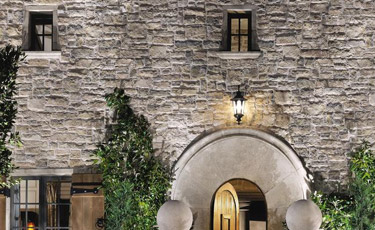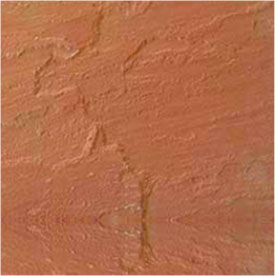Embrace A Modern Home Décor With Limestone Tiles
February 6, 2023 AdminThe use of limestone in architecture is nothing new
as this beautiful natural stone is being in both residential and commercial
structures worldwide. Primarily used for flooring, limestone tiles are also
used for several other applications like paving, wall cladding, and others. The
neutral earthy color-tone of this beautiful natural stone makes it a stone of
choice for architects, homeowners, stone fabricators, and others. Be it rustic,
farmhouse, or classic décor them, limestone complements all in a way like no
other.

What is limestone?
Limestone is considered a carbonic sedimentary rock which is primarily made up of aragonite and calcite. For thousands of years, limestone has been used as a building material due to its hardness and durability. Even, the great pyramids of Giza are made up of limestone. The modern buildings made a significant use of limestone during the construction. Builders mainly use limestone as tiles, bricks, cement, and fillers.
Below are some big reasons why limestone tiles are so popular in modern construction.

A Wide range of Design and Colors
There are several earthy tones and finishes available for limestone tiles, including brushed, tumbled, polished, and honed. It may be set up in many different ways, including tiles and slabs. There are several solutions available to fit every area of your living space.
Flexibility
Natural stone tiles, such as limestone, provide you the freedom to design your house anyway you desire while maintaining its beauty and refinement. Whatever option you select, it is ideal.


Affordability
Because of their gorgeous beauty, durability, and ease of care, natural stones like limestones value with time. It’s a tile without any prohibitive expenses. It may improve the look and feel of your house.
Easy Maintenance
Maintaining limestone flooring is simple. Cleaning marble flooring just requires regular sweeping and the occasional application of stone cleaner to a wet mop.


Eternal Beauty
Unlike all the other tiles you may see, the Limestone design and beauty never go out of style. Your choice of house design style will work with its timeless appearance.
Different Finishes in Limestone Tiles
Limestone is considered a permeable stone with natural cavities. Some surface finishes minimize the imperfections by filling them, whereas others do not. Granite floor tiles may be found in five different finishes: polished, honed, tumbled, brushed, and sandblasted.
Polished Limestone Tile – Manufacturers cover the holes in the limestone and polish the surface to an improved gloss to produce polished limestone tiles. This draws attention to the surface’s faint tint of limestone. For floors and walls, its reflecting surface is highly valued. The slickest surface is the polished one.
Honed Limestone Tile – The honed finish is matte and non-reflective, in contrast to polished limestone tiles. This makes the surface more slip-resistant and dulls the color of the limestone.
Tumbled Limestone Tile – Also filled are polished limestone tiles. The honed finish is matte and non-reflective, in contrast to polished limestone tiles. This makes the surface more slip-resistant and dulls the color of the limestone.
Brushed Limestone Tile – Manufacturers prepare brushed finish limestone tiles by employing a wire brush to vanish the soft surface of the limestone and reveal the lower fossilization. This results in a bit of rough texture. This is perfect for use in high-traffic areas such as kitchens.
Sandblasted Limestone Tile – Manufacturers create brushed limestone tiles by using a wire brush to remove the soft surface of the limestone and expose the lower fossilization. This creates a slightly rough texture. This is good in high-traffic areas like kitchens.
Limestone Varieties
Depending on its mineral makeup and physical makeup, limestone may be found in a wide range of types with a variety of textures and porosities. It’s white or almost white when made only of calcium carbonate. Magnesium, iron, or manganese may also be present in limestone, all of which will alter how white it is. Chert, clay, flint, sand, organic residue, and iron oxide all contribute to the creation of other hues including grey, yellow, and brown. Scratching is simple on limestone. It is a soft rock with a density of 2.5 to 2.7 grammes per cubic centimetre and a hardness of 3 to 4 Mohs.

A kind of limestone called travertine is created by mineral deposits around waterfalls, hot or cold springs, and along streams. Rapid precipitation of calcite results in the formation of this sedimentary stone. Calcite and other minerals combine to produce remarkable swirls and movement that give travertine its distinguishing appearance.
Limestone that is soft, white, and porous is called chalk. Over millions of years, the calcite mineral remnants of microorganisms gradually build up to become chalk in shallow seas. Chalk has been mined since prehistoric times and serves as both a construction material and a field soil conditioner. The renowned Dover White Cliffs in Kent, England, are made completely of layers of chalk.

Limestone Extraction
Depending on the rock’s hardness, limestone is removed from quarries and underground mines by mechanical excavation or blasting.
Limestone is taken from the Earth’s surface when it is mined from a quarry, commonly known as open pit mining or surface mining. The overburden (the material underneath the top soil that covers the mineral) is removed after the top soil has been removed. In order to shatter the rocks, drilling is used. Explosives are used to remove large boulders that are difficult to drill through in order to get at the limestone.
Additionally, limestone may be mined underground. When limestone is found more than 100 metres below the surface or when the topsoil surrounding the material is extremely hard, underground mining is used. Horizontal drills result in substantially smaller blast holes than open pit mining. Each time explosives are sent down the holes, a significant amount of rock is produced. After blasting, scaling rig equipment is used to remove the loose rocks from the mine.








